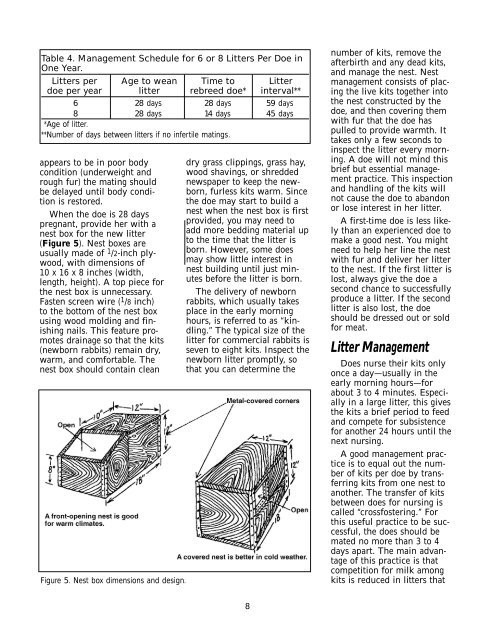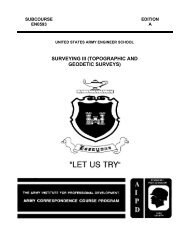Backyard Production of Meat Rabbits in Texas - World Rabbit ...
Backyard Production of Meat Rabbits in Texas - World Rabbit ...
Backyard Production of Meat Rabbits in Texas - World Rabbit ...
- No tags were found...
You also want an ePaper? Increase the reach of your titles
YUMPU automatically turns print PDFs into web optimized ePapers that Google loves.
Table 4. Management Schedule for 6 or 8 Litters Per Doe <strong>in</strong>One Year.Litters per Age to wean Time to Litterdoe per year litter rebreed doe* <strong>in</strong>terval**6 28 days 28 days 59 days8 28 days 14 days 45 days*Age <strong>of</strong> litter.**Number <strong>of</strong> days between litters if no <strong>in</strong>fertile mat<strong>in</strong>gs.appears to be <strong>in</strong> poor bodycondition (underweight andrough fur) the mat<strong>in</strong>g shouldbe delayed until body conditionis restored.When the doe is 28 dayspregnant, provide her with anest box for the new litter(Figure 5). Nest boxes areusually made <strong>of</strong> 1 /2-<strong>in</strong>ch plywood,with dimensions <strong>of</strong>10 x 16 x 8 <strong>in</strong>ches (width,length, height). A top piece forthe nest box is unnecessary.Fasten screen wire ( 1 /8 <strong>in</strong>ch)to the bottom <strong>of</strong> the nest boxus<strong>in</strong>g wood mold<strong>in</strong>g and f<strong>in</strong>ish<strong>in</strong>gnails. This feature promotesdra<strong>in</strong>age so that the kits(newborn rabbits) rema<strong>in</strong> dry,warm, and comfortable. Thenest box should conta<strong>in</strong> cleanFigure 5. Nest box dimensions and design.dry grass clipp<strong>in</strong>gs, grass hay,wood shav<strong>in</strong>gs, or shreddednewspaper to keep the newborn,furless kits warm. S<strong>in</strong>cethe doe may start to build anest when the nest box is firstprovided, you may need toadd more bedd<strong>in</strong>g material upto the time that the litter isborn. However, some doesmay show little <strong>in</strong>terest <strong>in</strong>nest build<strong>in</strong>g until just m<strong>in</strong>utesbefore the litter is born.The delivery <strong>of</strong> newbornrabbits, which usually takesplace <strong>in</strong> the early morn<strong>in</strong>ghours, is referred to as “k<strong>in</strong>dl<strong>in</strong>g.”The typical size <strong>of</strong> thelitter for commercial rabbits isseven to eight kits. Inspect thenewborn litter promptly, sothat you can determ<strong>in</strong>e thenumber <strong>of</strong> kits, remove theafterbirth and any dead kits,and manage the nest. Nestmanagement consists <strong>of</strong> plac<strong>in</strong>gthe live kits together <strong>in</strong>tothe nest constructed by thedoe, and then cover<strong>in</strong>g themwith fur that the doe haspulled to provide warmth. Ittakes only a few seconds to<strong>in</strong>spect the litter every morn<strong>in</strong>g.A doe will not m<strong>in</strong>d thisbrief but essential managementpractice. This <strong>in</strong>spectionand handl<strong>in</strong>g <strong>of</strong> the kits willnot cause the doe to abandonor lose <strong>in</strong>terest <strong>in</strong> her litter.A first-time doe is less likelythan an experienced doe tomake a good nest. You mightneed to help her l<strong>in</strong>e the nestwith fur and deliver her litterto the nest. If the first litter islost, always give the doe asecond chance to successfullyproduce a litter. If the secondlitter is also lost, the doeshould be dressed out or soldfor meat.Litter ManagementDoes nurse their kits onlyonce a day—usually <strong>in</strong> theearly morn<strong>in</strong>g hours—forabout 3 to 4 m<strong>in</strong>utes. Especially<strong>in</strong> a large litter, this givesthe kits a brief period to feedand compete for subsistencefor another 24 hours until thenext nurs<strong>in</strong>g.A good management practiceis to equal out the number<strong>of</strong> kits per doe by transferr<strong>in</strong>gkits from one nest toanother. The transfer <strong>of</strong> kitsbetween does for nurs<strong>in</strong>g iscalled “crossfoster<strong>in</strong>g.” Forthis useful practice to be successful,the does should bemated no more than 3 to 4days apart. The ma<strong>in</strong> advantage<strong>of</strong> this practice is thatcompetition for milk amongkits is reduced <strong>in</strong> litters that8

















